Windrow Composting: Difference between revisions
No edit summary Tags: Mobile edit Mobile web edit |
add page specific text |
||
| Line 1: | Line 1: | ||
[[Category:Technologies & Solutions]] | [[Category:Technologies & Solutions]] | ||
Open Air Windrow Composting ([[OAW]]) uses naturally occurring microbes which feed on organic material | '''Open Air Windrow Composting''' ([[OAW]]) is a means of treating [[Green Waste]] and uses naturally occurring microbes which feed on organic material and require oxygen. Open Air windrow Composting is therefore a form of [[Aerobic Digestion]] and by processing the the organic material the treatment process produces a compost material. | ||
[[File:Windrow composting pic.jpg|300px|left|Windrows of compost in a processing plant source Suffolk recycling]]__TOC__ | |||
<br clear='left'/> | |||
==Overview== | |||
OAW is a relatively inexpensive way of treating [[Green Waste]] e.g. twigs, leaves, glass cuttings and branch prunings etc. and is generally not suitable for [[Food Waste]] because of the legislative requirements to deal with [[Animal By-product Material]] - which generally requires management in [[In Vessel Composting]] or [[Anaerobic Digestion]] treatment processes. The process to turn the original material into the compost type material takes around 12 to 16 weeks. | |||
==The Process== | |||
===Stage 1=== | |||
The delivery of the [[Green Waste]] is delivered to the site (which has to have an [[Environmental Permit]]) and large items of contamination such as plastic, metal etc. are removed. The material is then shredded to produce a uniform particle size which is has a structure to allow air to pass through it during the treatment process. | |||
[[File:Compost shredding pic.jpg|400px|left|Shreeding green waste source kps-UK.com]]__TOC__ | |||
<br clear='left/> | |||
===Stage 2=== | |||
The shredded material is then placed into piles in long rows known as ‘windrows’, in the open air. The composting process is kick-started by naturally occurring micro-organisms already in the waste. They break down the material, releasing nutrients (and producing heat and some steam) and in doing so they increase the temperature to around 65<sup>o</sup>C needed to pathogens and kill weed seeds and meet the criteria for the final product quality specification. | |||
===Stage 3=== | |||
Each windrow is individually monitored and when the temperature has been reached and held for at least 7 days it is then turned to mix the material and ensure an even distribution of the composting process and to introduce sufficient oxygen to ensure the process does not turn anaerobic. The turning of the windrows may occur up to 8 times or more before a stabilised compost is produced. The turning process can be done with simple tractor/shovel type machines, or dedicated turning machines that introduce some additional mechanical breakdown of the material. | |||
{| class="wikitable" | |||
|- | |||
| [[File:Windfrwo turning pic.jpg|300px|left|Turning windrow with shovel source linkedin.com]] || [[File:Windrow turner pic.jpg|360px|left|windrow turning with dedicated plant source bizjournals.com]] | |||
|} | |||
There are three discreet phases in the overall process<ref>[https://www.thecompostshop.co.uk/how-organic-compost-is-made The Compost Shop Website]</ref>: | |||
* '''Sanitation''' - temperature must be held above 65 degrees, for at least 7 days, and turned at least twice | |||
* '''Stabilisation''' - temperature maintained above 55 degrees, managed for 10 weeks, and turned at least 6 times | |||
* '''Maturation''' - Post-screening (stage 4 below) the product is generally stored for at least 4 weeks before it can be used | |||
The | ===Stage 4=== | ||
Stabilised material is screened, and any remaining contaminants removed, to produce a range of product grades for various end uses such as soil conditioning/a soil improvement material providing it meets the Quality Standard [[PAS100]] which dictates the process standard to ensure that it meets [[End of Waste Criteria]]. Any large materials that have not fully broken down in the process (such as larger branches) are taken from the screening process and re-introduced back into the process as outlined above. | |||
[[File:Screening compost pic.jpg|300px|left|Screening compost source growingagreenerworld.com]]__TOC__ | |||
<br clear='left/> | |||
The different grades of compost can be used for different purposes. Some grades are used as agricultural soil conditioners, others as mulches and others are suitable for landscape gardening or finer grades can be used on golf courses. In some cases the material is blended with other material to produce other products for horticultural use (for example sand)<ref>[http://www.freelandhorticulture.co.uk/products-and-services/composting.html Freeland Horticulture Website]</ref>. | |||
The different grades of compost can be used for different purposes. Some grades are used as agricultural soil conditioners, others as mulches and others are suitable for landscape gardening or finer grades can be used on golf courses. | |||
==References== | ==References== | ||
<references /> | <references /> | ||
Revision as of 11:33, 9 May 2020
Open Air Windrow Composting (OAW) is a means of treating Green Waste and uses naturally occurring microbes which feed on organic material and require oxygen. Open Air windrow Composting is therefore a form of Aerobic Digestion and by processing the the organic material the treatment process produces a compost material.
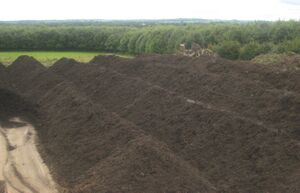
Overview
OAW is a relatively inexpensive way of treating Green Waste e.g. twigs, leaves, glass cuttings and branch prunings etc. and is generally not suitable for Food Waste because of the legislative requirements to deal with Animal By-product Material - which generally requires management in In Vessel Composting or Anaerobic Digestion treatment processes. The process to turn the original material into the compost type material takes around 12 to 16 weeks.
The Process
Stage 1
The delivery of the Green Waste is delivered to the site (which has to have an Environmental Permit) and large items of contamination such as plastic, metal etc. are removed. The material is then shredded to produce a uniform particle size which is has a structure to allow air to pass through it during the treatment process.
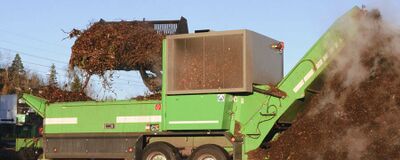
Stage 2
The shredded material is then placed into piles in long rows known as ‘windrows’, in the open air. The composting process is kick-started by naturally occurring micro-organisms already in the waste. They break down the material, releasing nutrients (and producing heat and some steam) and in doing so they increase the temperature to around 65oC needed to pathogens and kill weed seeds and meet the criteria for the final product quality specification.
Stage 3
Each windrow is individually monitored and when the temperature has been reached and held for at least 7 days it is then turned to mix the material and ensure an even distribution of the composting process and to introduce sufficient oxygen to ensure the process does not turn anaerobic. The turning of the windrows may occur up to 8 times or more before a stabilised compost is produced. The turning process can be done with simple tractor/shovel type machines, or dedicated turning machines that introduce some additional mechanical breakdown of the material.
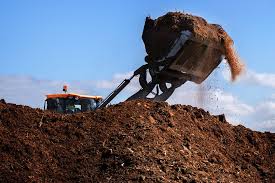 |
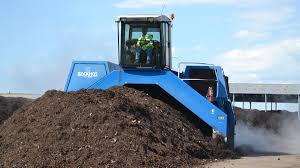 |
There are three discreet phases in the overall process[1]:
- Sanitation - temperature must be held above 65 degrees, for at least 7 days, and turned at least twice
- Stabilisation - temperature maintained above 55 degrees, managed for 10 weeks, and turned at least 6 times
- Maturation - Post-screening (stage 4 below) the product is generally stored for at least 4 weeks before it can be used
Stage 4
Stabilised material is screened, and any remaining contaminants removed, to produce a range of product grades for various end uses such as soil conditioning/a soil improvement material providing it meets the Quality Standard PAS100 which dictates the process standard to ensure that it meets End of Waste Criteria. Any large materials that have not fully broken down in the process (such as larger branches) are taken from the screening process and re-introduced back into the process as outlined above.
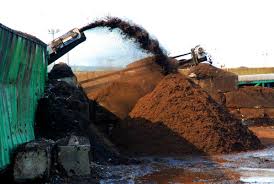
The different grades of compost can be used for different purposes. Some grades are used as agricultural soil conditioners, others as mulches and others are suitable for landscape gardening or finer grades can be used on golf courses. In some cases the material is blended with other material to produce other products for horticultural use (for example sand)[2].
